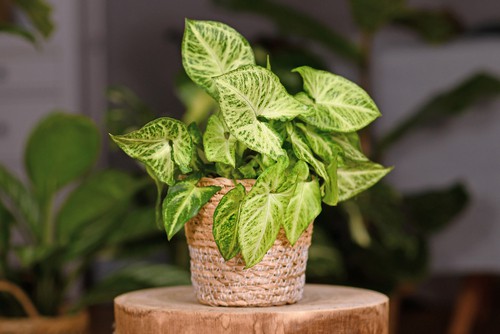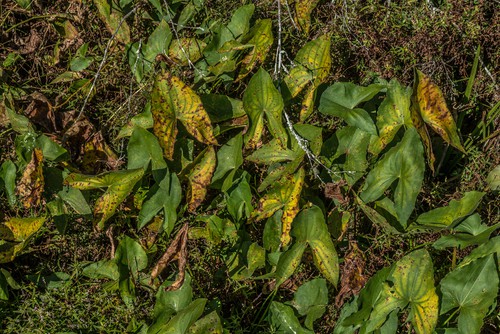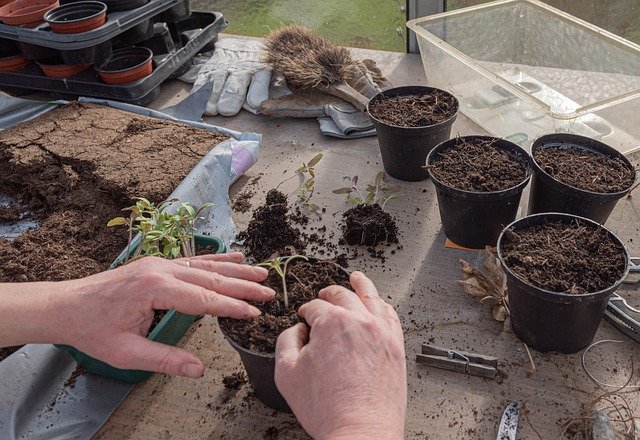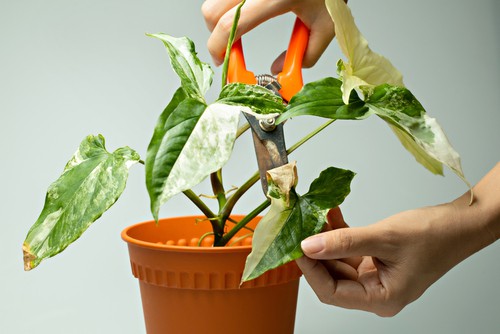Arrowhead plants are popular houseplants known for their attractive foliage and ease of care. However, one common issue that many people face is their arrowhead plant leaves turning brown. This can be concerning, but there are several reasons why this can happen and steps you can take to prevent and treat it.
To understand why arrowhead plant leaves turn brown, it’s important to first understand the plant itself. Arrowhead plants, also known as Syngonium podophyllum, are tropical plants native to South America.
They are typically grown as indoor plants and can thrive in a range of lighting conditions. However, they do require regular watering and proper drainage to prevent issues like root rot.
There are several common problems that arrowhead plants can face, including pests, diseases, and environmental stress. Brown leaves are a common symptom of these issues and can indicate a problem with watering, light, or fertilizer.
It’s important to identify the underlying cause of the problem to properly treat it. With proper care and attention, you can help your arrowhead plant thrive and prevent issues like brown leaves.
Key Takeaways
- Arrowhead plants are tropical houseplants that require regular watering and proper drainage.
- Brown leaves on arrowhead plants can indicate a problem with watering, light, or fertilizer.
- Identifying the underlying cause of brown leaves is important for proper treatment and prevention of future issues.
Don’t miss out on these other popular posts:
- Blue Point Juniper Turning Brown Inside:
- Blue Fescue Grass Turning Brown
- Blackberry Leaves Turning Brown
Understanding Arrowhead Plant

Arrowhead plant, also known as Syngonium or Syngonium podophyllum, is a popular houseplant that belongs to the Araceae family. It is native to South America but is commonly grown in Florida and other tropical regions. Arrowhead plant is a versatile plant that can be grown in different light conditions and can be trained to climb or left to trail.
Arrowhead plants come in different varieties, each with its unique leaf shape, color, and texture.
Some popular varieties include African evergreen, Maria Allusion, Berry Allusion, Emerald Gem, Emerald Green, Holly, Pink Allusion, Pixie, Strawberry Cream, Trileaf Wonder, and White Butterfly. The leaves of arrowhead plants are typically arrow-shaped, hence the name. The leaves can be green, variegated, or even pink.
Arrowhead plant is a low-maintenance plant that can thrive in a range of conditions. It prefers bright, indirect light but can tolerate low light. Direct sunlight can scorch the leaves, causing them to turn brown.
Arrowhead plant also likes moist soil but can suffer from root rot if overwatered. It is essential to let the top inch of soil dry out before watering the plant again.
Arrowhead plant is a versatile plant that can be grown in different types of soil, including peat moss, perlite, and vermiculite. It is a fast-growing plant that can benefit from regular fertilization during the growing season. Arrowhead plant is generally pest-free but can suffer from spider mites, mealybugs, and scale insects.
Arrowhead Plant Leaves Turning Brown – 5 Common Problems
Arrowhead plants are generally easy to care for and maintain, but they can experience a few common problems that may cause their leaves to turn brown, yellow, or droop. Here are some of the most common issues that arrowhead plant owners may encounter:
1. Improper Watering
Improper watering is one of the most common problems with arrowhead plants. Overwatering or underwatering can cause the leaves to turn brown, yellow, or droop. It is important to water the plant properly and maintain consistent moisture levels in the soil. Arrowhead plants prefer a well-draining soil that is kept slightly moist, but not waterlogged.
2. Low Humidity
Arrowhead plants thrive in a warm and humid environment. Low humidity around the plant can cause the leaves to turn brown and the plant to become droopy. To prevent this problem, it is important to maintain a humid environment around the plant. This can be achieved by misting the plant regularly or placing a humidifier nearby.
3. Excessive Light
Arrowhead plants prefer bright, indirect light. Exposing the plant to direct sunlight can cause the leaves to turn brown and scorch. If the plant is receiving too much light, it may be necessary to move it to a location with less direct sunlight.
4. Leaf Spot Diseases
Arrowhead plants are susceptible to leaf spot diseases, which can cause brown spots or lesions on the leaves. These diseases are caused by fungi or bacteria and can be spread through contaminated soil or water. To prevent leaf spot diseases, it is important to avoid overwatering and maintain good hygiene practices when caring for the plant.
5. Overfertilization
Overfertilization can cause the leaves of the arrowhead plant to turn brown and curl. It is important to follow the recommended fertilization schedule and avoid overfeeding the plant. Too much fertilizer can also cause the soil to become too acidic, which can harm the plant.
Causes of Brown Leaves

Arrowhead plants are popular houseplants that can add a touch of greenery to any indoor space. However, when the leaves start turning brown, it can be frustrating for plant owners. Brown leaves are a sign that something is wrong with the plant, and it is important to identify the cause and fix it before it’s too late.
The most common cause of brown leaves in arrowhead plants is low humidity. These tropical plants require high humidity to thrive, and when the air is too dry, the leaves will start turning brown. To prevent this, it is important to keep the plant in a room with high humidity or use a humidifier to increase the moisture in the air.
Overwatering or underwatering can also cause brown leaves in arrowhead plants. When the soil is too wet or too dry, the plant will start to suffer, and the leaves will turn brown. It is important to water the plant properly and ensure that the soil is moist but not waterlogged. The top inch of soil should be allowed to dry out before watering again.
Another cause of brown leaves in arrowhead plants is over-fertilization. Too much fertilizer can cause a buildup of salts in the soil, which can burn the roots and cause the leaves to turn brown. It is important to follow the recommended dosage of fertilizer and avoid over-fertilizing the plant.
Direct sunlight exposure can also cause brown leaves in arrowhead plants. These plants prefer bright, indirect light and can suffer from sunburn if exposed to direct sunlight for too long. It is important to keep the plant in a location with bright, indirect light and avoid placing it in direct sunlight.
In summary, the causes of brown leaves in arrowhead plants can be attributed to humidity, improper watering, over-fertilization, and direct sunlight exposure. By identifying the cause and taking the necessary steps to fix the problem, plant owners can ensure that their arrowhead plants stay healthy and vibrant.
Prevention and Treatment
Arrowhead plants are prone to turning brown due to various reasons such as improper watering, low humidity levels, and insufficient lighting. However, there are several steps that can be taken to prevent and treat brown leaves on arrowhead plants.
1. Watering and Moisture
Proper watering and moisture levels are crucial to prevent arrowhead plant leaves from turning brown. Overwatering or underwatering can cause stress to the plant, resulting in brown leaves.
It is recommended to water the plant thoroughly once a week or when the top inch of the soil feels dry to the touch. Be sure to use room temperature water and avoid getting water on the leaves, as this can cause them to rot.
Maintaining adequate moisture levels in the air around the plant can also help prevent brown leaves. Using a humidifier or placing a tray of water near the plant can increase humidity levels. Misting the leaves with a spray bottle can also provide a short-term increase in humidity, but it is not the best way to maintain moisture.
2. Fertilizing and Pruning
Fertilizing the arrowhead plant with organic compost or a balanced fertilizer can help prevent brown leaves by providing essential nutrients to the plant. It is recommended to fertilize the plant every two weeks during the growing season.
Pruning the plant can also help prevent brown leaves by removing any dead or damaged leaves. Trim the plant back to encourage new growth and maintain its shape.
3. Potting and Lighting

Proper potting and lighting are also important factors in preventing brown leaves on arrowhead plants. Ensure the plant is potted in well-draining soil with a drainage hole to prevent water from sitting in the bottom of the pot. Use a potting mix that is rich in organic matter.
Arrowhead plants prefer indirect sunlight, so be sure to place the plant in a location where it receives bright, filtered light. Direct sunlight can cause the leaves to burn and turn brown.
Additional Care Tips
To prevent arrowhead plant leaves from turning brown, proper care is essential. Here are some additional care tips that can help ensure healthy growth and prevent browning of leaves.
1. Watering
Arrowhead plants prefer well-drained soil that is kept consistently moist. Overwatering can lead to root rot, while underwatering can cause dehydration and brown spots on the leaves. It’s important to strike a balance between the two.
One way to check if the plant needs water is to stick a finger into the soil. If the top inch of soil feels dry, it’s time to water the plant. Use room temperature water and avoid getting water on the foliage, as this can cause brown leaf tips.
2. Lighting
Arrowhead plants thrive in bright, indirect light. Direct sunlight can scorch the leaves, while low light can cause the plant to become leggy and lose its foliage. If the plant is getting too much light, the leaves may turn brown or yellow.
3. Humidity

Arrowhead plants are native to humid environments, so they prefer high humidity levels. Dry air can cause the leaves to turn brown and crispy. To increase humidity levels, consider placing a tray of water near the plant or using a humidifier.
4. Fertilizing
Arrowhead plants are low maintenance and do not require frequent fertilization. Over-fertilizing can cause the leaves to turn brown and fall off. Use a balanced fertilizer once a month during the growing season to promote healthy growth.
5. Repotting
Arrowhead plants do not require frequent repotting, but it’s important to repot them once every two years to ensure healthy growth. Use a well-draining soil mix and a pot that is one size larger than the current one.
6. Dormancy
Arrowhead plants may go dormant during the winter months. During this time, they require less water and fertilizer. Reduce watering to once every two weeks and avoid fertilizing until the plant begins to show signs of new growth.
By following these additional care tips, arrowhead plant owners can prevent leaves from turning brown and ensure healthy growth. For more information on arrowhead plant care, check out this ebook.
Frequently Asked Questions
How often should I water my arrowhead plant?
Arrowhead plants thrive in moist soil, but it is important to avoid overwatering. As a general rule, water your arrowhead plant when the top inch of soil feels dry to the touch. Be sure to use well-draining soil and a pot with drainage holes to prevent water from accumulating in the soil.
Why are my Syngonium leaves turning brown?
Syngoniums, also known as arrowhead plants, can develop brown leaves for a variety of reasons. One common cause is underwatering, which can cause the leaves to dry out and turn brown. Other causes include low humidity, exposure to direct sunlight, and nutrient deficiencies.
Why is my Syngonium getting brown spots?
Brown spots on Syngonium leaves can be caused by a fungal infection known as leaf spot disease. This disease is characterized by small brown spots on the leaves that may spread and merge over time. To prevent leaf spot disease, be sure to avoid overwatering and provide good air circulation around the plant.
What causes brown spots on arrowhead plant leaves?
Brown spots on arrowhead plant leaves can be caused by a variety of factors, including leaf spot disease, insect infestations, and exposure to direct sunlight. It is important to identify the underlying cause of the brown spots in order to treat the problem effectively.
What is the treatment for arrowhead leaf spot disease?
If your arrowhead plant is affected by leaf spot disease, it is important to remove any infected leaves and improve air circulation around the plant. You can also treat the plant with a fungicide to help prevent the spread of the disease.
Why is my arrowhead plant turning yellow and brown?
Yellowing and browning of arrowhead plant leaves can be caused by a variety of factors, including overwatering, underwatering, nutrient deficiencies, and exposure to direct sunlight. It is important to identify the underlying cause of the problem in order to treat it effectively.

Hey, I’m Lisa and I’ve been an avid gardener for over 30 years. I love writing, talking and living in the garden! Feel free to connect with me on my socials below


